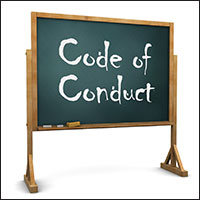 Student code of conduct is bewildering
Student code of conduct is bewildering
STORY
Student behavior problems were the number one concern parents and teachers raised in a recent five-year strategic plan meeting, but dealing with those concerns is complicated by the School District’s unclear and confusing student code of conduct.
How confusing is the lengthy written document that parents are required to sign when enrolling their children in school?
Well, when School Board Member Laura Zorc studied the code to see how it had been applied in what she called “a serious school incident,” she admitted “it was Greek” to her.
And that was last year’s version. This year’s 72-page revised code is even more dense and incomprehensible to the average reader, larded with charts, appendixes, acronyms and jargon.
Problems with the document start with the fact it violates state rules that require school boards to adopt separate elementary, middle and high school codes of conduct, written in language students and parents can understand.
The School District is offering up only one code for all grades, the so-called “Positive Climate and Discipline Code of Student Conduct.”
In the first few pages, the document announces it has been devised to be complex: “A simple consequence-based model of discipline is not effective,” the code states, so the district has devised a “Multi-Tiered System of Supports (MTSS) framework.”
There is a 16-page chart of the “five levels of interventions and consequences” that is supposed to boil it down for the user, but it refers to about a dozen behavioral modification programs only briefly defined in an appendix at the end of the document.
Each school must adopt one of these behavioral programs and incorporate it into the academic curriculum.
Zorc noted that Indian River Academy’s use of the “Conscious Discipline” program has been successful, praising Principal Diane Fannin for providing teacher support and training. Yet “Conscious Discipline” is not among the behavior programs listed and briefly defined in the code appendix, raising the question whether it is a sanctioned behavior program.
The consequences of confusion about what violates rules can be dire. If a student has already been in trouble with the law, a suspension for violating a code even a School Board member can’t understand can lead to probation violation and arrest.
Last school year, student arrests, some triggered at least in part by violations of the student code, were up from 39 to 72, an 85 percent increase. These school-related arrests comprised 26 percent of all juvenile arrests in the county.
Of the roughly 4,300 public schools in the state, Vero Beach High School ranked 26th for juvenile arrests in the 2015-2016 school year.
Sheriff’s deputies employed as “School Resource Officers” at the four middle schools and two high schools can claim a student is gang-affiliated without evidence of criminal activity.
In an incident last year, 12 students were detained because of hand gestures captured in a group photo taken on the Vero Beach High School campus and posted on Facebook.
The student code mandates suspension for gang-related activity but does not clearly define such activity. Nevertheless, for seven of the students who were on probation, the suspension was a violation and they were taken to the Fort Pierce juvenile detention center and then hauled into court.
Dr. Jacqueline Warrior, NAACP education committee chairperson and “juvenile court watcher” for the state prosecutor and Department of Juvenile Justice for five years, tried to get the gang-related activity part of the code rewritten to so that criminal activity would have to be proved before a gang tag could be attached to a student, but she was unsuccessful.
Executive Director of Student Services and Exceptional Education Services Lillian Torres-Martinez, who drafted the code the last two years, was asked why the gang-related activity language was not fixed, but she did not respond.








